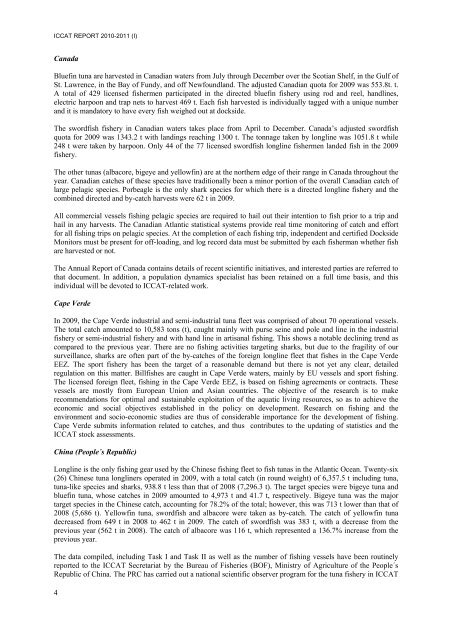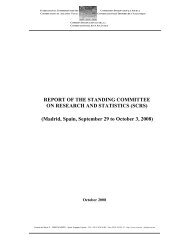REPORT OF THE STANDING COMMITTEE ON RESEARCH ... - Iccat
REPORT OF THE STANDING COMMITTEE ON RESEARCH ... - Iccat
REPORT OF THE STANDING COMMITTEE ON RESEARCH ... - Iccat
Create successful ePaper yourself
Turn your PDF publications into a flip-book with our unique Google optimized e-Paper software.
ICCAT <strong>REPORT</strong> 2010-2011 (I)<br />
Canada<br />
Bluefin tuna are harvested in Canadian waters from July through December over the Scotian Shelf, in the Gulf of<br />
St. Lawrence, in the Bay of Fundy, and off Newfoundland. The adjusted Canadian quota for 2009 was 553.8t. t.<br />
A total of 429 licensed fishermen participated in the directed bluefin fishery using rod and reel, handlines,<br />
electric harpoon and trap nets to harvest 469 t. Each fish harvested is individually tagged with a unique number<br />
and it is mandatory to have every fish weighed out at dockside.<br />
The swordfish fishery in Canadian waters takes place from April to December. Canada’s adjusted swordfish<br />
quota for 2009 was 1343.2 t with landings reaching 1300 t. The tonnage taken by longline was 1051.8 t while<br />
248 t were taken by harpoon. Only 44 of the 77 licensed swordfish longline fishermen landed fish in the 2009<br />
fishery.<br />
The other tunas (albacore, bigeye and yellowfin) are at the northern edge of their range in Canada throughout the<br />
year. Canadian catches of these species have traditionally been a minor portion of the overall Canadian catch of<br />
large pelagic species. Porbeagle is the only shark species for which there is a directed longline fishery and the<br />
combined directed and by-catch harvests were 62 t in 2009.<br />
All commercial vessels fishing pelagic species are required to hail out their intention to fish prior to a trip and<br />
hail in any harvests. The Canadian Atlantic statistical systems provide real time monitoring of catch and effort<br />
for all fishing trips on pelagic species. At the completion of each fishing trip, independent and certified Dockside<br />
Monitors must be present for off-loading, and log record data must be submitted by each fisherman whether fish<br />
are harvested or not.<br />
The Annual Report of Canada contains details of recent scientific initiatives, and interested parties are referred to<br />
that document. In addition, a population dynamics specialist has been retained on a full time basis, and this<br />
individual will be devoted to ICCAT-related work.<br />
Cape Verde<br />
In 2009, the Cape Verde industrial and semi-industrial tuna fleet was comprised of about 70 operational vessels.<br />
The total catch amounted to 10,583 tons (t), caught mainly with purse seine and pole and line in the industrial<br />
fishery or semi-industrial fishery and with hand line in artisanal fishing. This shows a notable declining trend as<br />
compared to the previous year. There are no fishing activities targeting sharks, but due to the fragility of our<br />
surveillance, sharks are often part of the by-catches of the foreign longline fleet that fishes in the Cape Verde<br />
EEZ. The sport fishery has been the target of a reasonable demand but there is not yet any clear, detailed<br />
regulation on this matter. Billfishes are caught in Cape Verde waters, mainly by EU vessels and sport fishing.<br />
The licensed foreign fleet, fishing in the Cape Verde EEZ, is based on fishing agreements or contracts. These<br />
vessels are mostly from European Union and Asian countries. The objective of the research is to make<br />
recommendations for optimal and sustainable exploitation of the aquatic living resources, so as to achieve the<br />
economic and social objectives established in the policy on development. Research on fishing and the<br />
environment and socio-economic studies are thus of considerable importance for the development of fishing.<br />
Cape Verde submits information related to catches, and thus contributes to the updating of statistics and the<br />
ICCAT stock assessments.<br />
China (People´s Republic)<br />
Longline is the only fishing gear used by the Chinese fishing fleet to fish tunas in the Atlantic Ocean. Twenty-six<br />
(26) Chinese tuna longliners operated in 2009, with a total catch (in round weight) of 6,357.5 t including tuna,<br />
tuna-like species and sharks, 938.8 t less than that of 2008 (7,296.3 t). The target species were bigeye tuna and<br />
bluefin tuna, whose catches in 2009 amounted to 4,973 t and 41.7 t, respectively. Bigeye tuna was the major<br />
target species in the Chinese catch, accounting for 78.2% of the total; however, this was 713 t lower than that of<br />
2008 (5,686 t). Yellowfin tuna, swordfish and albacore were taken as by-catch. The catch of yellowfin tuna<br />
decreased from 649 t in 2008 to 462 t in 2009. The catch of swordfish was 383 t, with a decrease from the<br />
previous year (562 t in 2008). The catch of albacore was 116 t, which represented a 136.7% increase from the<br />
previous year.<br />
The data compiled, including Task I and Task II as well as the number of fishing vessels have been routinely<br />
reported to the ICCAT Secretariat by the Bureau of Fisheries (B<strong>OF</strong>), Ministry of Agriculture of the People´s<br />
Republic of China. The PRC has carried out a national scientific observer program for the tuna fishery in ICCAT<br />
4

















